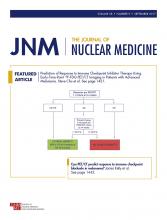REPLY: We thank Drs. Pakzad and Safiri for their interest in our paper (1). We agree that there are a variety of methodologic questions to potentially be discussed (2–4), but we disagree with their criticism of our paper.
First, they prefer an analysis of cause-specific survival over overall survival. Understanding causes of death is an important aim but is, perhaps, less pressing a question in oncology. We considered a cohort of patients with locally advanced, metastatic neuroendocrine tumors, for whom death would likely be related to this diagnosis and the subsequent disease course. Consequently, overall survival is the single most important time-to-event outcome in oncology. Pakzad and Safiri also argue that a cause-specific analysis would have required “newly presented” methodology, whereas, in fact, the required methodology falls within the realm of the well-established statistics of competing risks (5). We used such competing-risks methodology in our analysis of the incidence of diabetes after DOTATOC.
Second, they express concern about a possible misspecification of the Cox model. This is, in fact, a common concern in the analysis of time-to-event data. Cox regression is commonly used to study not only overall survival but composites such as progression-free survival and competing risks—that is, the single components of a composite outcome. It is impossible to correctly specify the Cox model for all these endpoints (6), and analyses must consequently be interpreted as time-averaged hazard ratios (7). We believe that the great usefulness of the Cox model is partly due to the meaningful summaries of effect that such time-averaged hazard ratios provide. Pakzad and Safiri refer to our Figure 3C, illustrating no incident diabetes event in the 177Lu-DOTATOC group, which theoretically corresponds to an infinite regression coefficient or a zero hazard ratio. In our analysis, we followed the advice of Therneau and Grambsch (section 3.4.1 (8)) in interpreting this result as representing a very pronounced reduction in the diabetes hazard.
Footnotes
Published online Mar. 9, 2017.
- © 2017 by the Society of Nuclear Medicine and Molecular Imaging.







